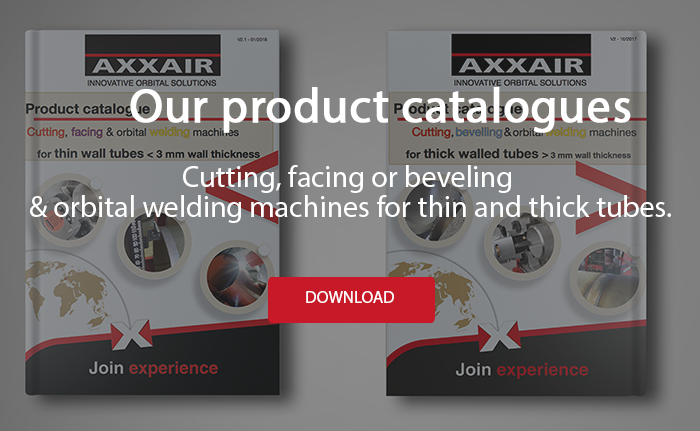Every country has its own designations for steels. The European standard EN10027 classifies four different categories of steels:
- Non alloyed standard steels for common use (construction) ;
- Special non-alloyed steels for thermal treatment, malleable, which can be welded or forged.
- Low alloyed steel for tempering and annealing
- High alloy steel:
- stainless steels,
- high speed steels, for high speed cutting tools such as drills
Let us distinguish the “standard” steels (non alloyed steels or low alloyed steel) and the stainless steels. Standard steel is less expensive than stainless steel, but it is not corrosion resistant. This has a direct impact on the conveyed fluids such as food, beverage, drugs or pure gas.
Stainless steel has become essential
Stainless steel has become essential for many purposes, applications and products: kitchenware, everyday objects, medical and chirurgical tools, construction and public works, ship construction, the automotive and aeronautical industry, tooling, the mechanical industry, food and beverage, chemical works, transport and so on. These markets have a large number of standards and they cannot take a standard steel as the sensitive fluids could be contaminated.
>> Which welding process to use to meet health standards?
The lifetime of stainless steel installations is longer when stainless steel has been used for construction. Due to its composition, they do not corrode, or don’t corrode much. So they are more resistant than standard steels. Standard steels are mostly used by construction enterprises and for buildings. They are used for external works when corrosion and oxidation are permitted.
What exactly is stainless steel and in which industries is it used?
Stainless steel is alloyed steel (with a minimum of 1.2% of carbon and more than 10.5% of chrome). This alloy has the property of not being corrosive and does not rust.
Having more than 10.5% of chrome creates a protective layer made of chromium oxide; this is the reason why stainless steel does not corrode.
MAIN FAMILIES OF STAINLESS STEELS:
- Ferritic: iron-chrome, carbon < 0,1 %, ferromagnetic (« magnetic »). The chrome and the molybdenum increase the resistance to corrosion. Titan and niobium improve the weldability.
- Martensitic: iron-chrome, carbon > 0,1 %, ferromagnetic (« magnetic »), can be hardened, for example in the case of the fabrication of a hammer which has to be stronger than the nail.
- Austenitic: iron-chrome-nickel, carbon < 0,1 %, this steel represents 65% of the stainless steel market;
- Duplex: iron-chrome-nickel, mixed structure austenitic-ferritic, magnetic: these steels have the best corrosion protection compared to other current austenitic or ferritic steels.
WHICH KIND OF TUBES FOR WHAT KIND OF INDUSTRY?
Generally speaking, stainless steel alloys are made in order to resist to corrosion, to oxidation and “creep behaviour” (distortion). The classification of the four types of stainless steels enables us to decide in which industry they can be used.
How to choose your welding process?
There is no official science or rules, as it will be the final use of the tube that has to be taken into account, but we can define the general uses as following:
- Ferritic steels:
They are used in order to form a resistance barrier for corrosion. They can also be used to equip the sides and panels) of pressure equipment made of steel in the petrochemical and chemical industries. They are equally used for the food and beverage industry.
- Martensitic steels:
They are used when high mechanical resistance is required. Remember the example of the importance of hardening the steel for the hammer and the nail in order to understand the interest in martensitic steels for a huge number of industries.
- Austenitic steels:
Due to their chemical resistance and their ductility – compared to copper – and their excellent mechanical characteristics they are the most used of stainless steels. They can also be used at very low temperatures (up to – 200°C), which is a good solution for cryogenic applications. You will also find marine applications with austenitic steels.
- Duplex steels:
They have a biphasic structure as they belong to the austenitic/ferritic steels. This grade of steel was initially produced as the chlorine and other aggressive chemicals present in the coolant water caused corrosion in the tubes inherent to the fabrication process. Duplex steel is also used in the paper and textile industry, for chemical, petrochemical and marine applications, for the pharmaceutical industry as well as for seawater desalinations or anti-pollution equipment.
Axxair machines are perfectly adapted for stainless steel
Our machines are perfectly adapted to weld standard steels as well as stainless steels, which is perfect for companies who use both grades. About 80 % of our customers use them for stainless steel as the conveyed fluids are often precious and need high quality welds, as well as repeatability and traceability - imperative in compliance with the quality standards requested in these industries.
We are most active in the food- and beverage industry (liquids, food components, beverage, and milk), the pharmaceutical industry (drugs and components), the semi-conductor market (gas or pure water), the aeronautic industry (tubes made of titan, low weight of components), the chemical and petrochemical industries (having most corrosive fluids).
Have a look at following examples of our equipment used for a multitude of industries and applications:
- Gas, petrochemicals, hydraulics, petrol: welding with open welding heads or machines for prefabrication: SATO or SP
- Pharmaceutical industry and food and beverage: Stainless Steel tubes: closed welding heads – SATF range
- Semi conductors, pharmaceutical industry: open welding head SATO and prefabrication
- Aeronautical and aerospace industry: titan – closed welding heads SATF range
This is just a short list of applications. Do not hesitate to contact us directly. Together we will find the solution for your project.





